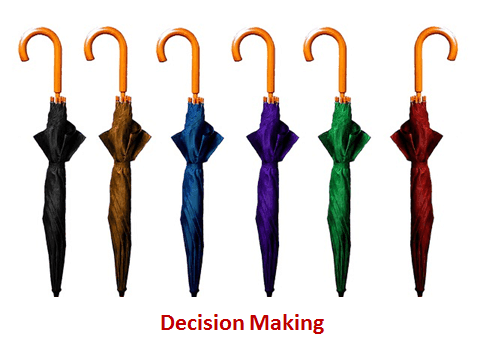
In order to be a successful “driver of the car”, the manager should make deliberate and accurate decisions. Such decisions should be undertaken when the organisation is not running properly in any way. The manager should “steer the wheel” and ask himself continually “Should I turn left now, or can I drive the car forward for a while and then turn to the left? “. These questions remind us that making no decision will also be a decision. To make proper decisions, managers ask for current and reliable management information.
Five steps to make proper decisions
The decision making process is made up of five phases (steps) from which I focus only on the first and last phase because traditional business intelligence solutions support basically these two phases. In essence, the decision making process is well depicted by the following questions (Simon, 1977):
1. Is there a problem? (intelligence)
2. What are the alternatives? (design)
3. Which alternative is the best? (choice)
4. How to implement? (implementation)
5. Is the choice working? (evaluation)
Wake up call: 'is there a problem?'
This first pre-decisional phase works as a trigger and should be considered as some kind of “wake up” moment. The environment is continually searched for information stimuli calling for decisions. When reality differs from the standard or is likely to differ, the necessity to make a decision becomes reality. In other words, every actual or foreseen deviation of the desired situation is a problem (Keuning and Eppink, 1993).
Identify the organizational goals
Such analysis should consider the problem in a non-isolated way and has to be viewed against the background of the whole and in relation to other parts of the organisation. Hence, this phase must be preceded by the identification of organizational goals and objectives or should at least be part of this phase (Turban, 1993). Information retrieval behaviour plays a significant role here and I devote a complete paragraph to this behaviour in chapter 4.
Make a set of decisions
Once the problem is perceived, interpreted and analyzed, the manager should, after having worked out phase 2, make a set of decisions, which can be translated to new objectives, actions, plans or standards. These new objectives should then be communicated to sub-ordinates in order to work out and implement the plans.
Communication about the figures should be part of BI software
A business intelligence software solution should therefore be able to communicate problems properly to the manager who can, in turn, analyze and communicate the problem to the persons concerned. Here the first part of the navigation of the problem ends because it should first be clear which alternative solutions are available. There is often time available between phase one and the completion of phase three. Therefore, after finishing the first part of the decision making process the navigation path(s) should be automatically saved for restoration for later use. Even so, it would be wise to place such a problem with related screens in a distinct area of the (main) screen where the location should depend on the severity of the problem. This could be, for example, derived from the relative importance of the measure and the degree of detail of the information that represents the problem[1].
Working out alternatives is often done by analysts
After having worked out alternatives, a choice has been made. Working out alternatives is often done by analysts and sub-ordinates and those phases are often not supported by business intelligence systems (Laudon, 1997). After having made the actual decision, this should be communicated to the businses intelligence system in order to let the manager see if the decision does indeed what it has been designed to achieve.
Keep the problem on the screen until it is solved
Until the decision is fully implemented and does solve the problem, the view that does represent the problem should remain on the screen. If, in the meantime, other problems occur, the older view can get a less prominent place on the screen only and if there is an improvement in the situation and the new problem is bigger and of higher importance.
Uncontrollable parameters
Furthermore, in the decision-making process, the manager can chart the problem in terms of decision, uncontrollable (or parameters) and results variables (Turban, 1993). Controllable variables, like the amount of investment, can be influenced in opposition to uncontrollable variables, like inflation rates and competition. Results variables reflect the level of effectiveness of the organisation; they indicate how well the system attains its goals.
Consequences for the user interface
First, the variation encountered here has consequences for the presentation of the interface. Decision variables can be displayed in a different way to uncontrollable variables. Furthermore, the behavior and presentation of the variables presented by the interface should be different when the manager is involved in a planning process. Decision and results variables can be increased or decreased as opposed to uncontrollable variables.
Problems lower in the hierarchy are often less severe
In general, the lower the user is in an hierarchy of a dimension, the more detailed the information, the less the figures amount to the total. So, problems detected in the lower region of the hierarchy can be perceived as less severe.
No comments:
Post a Comment